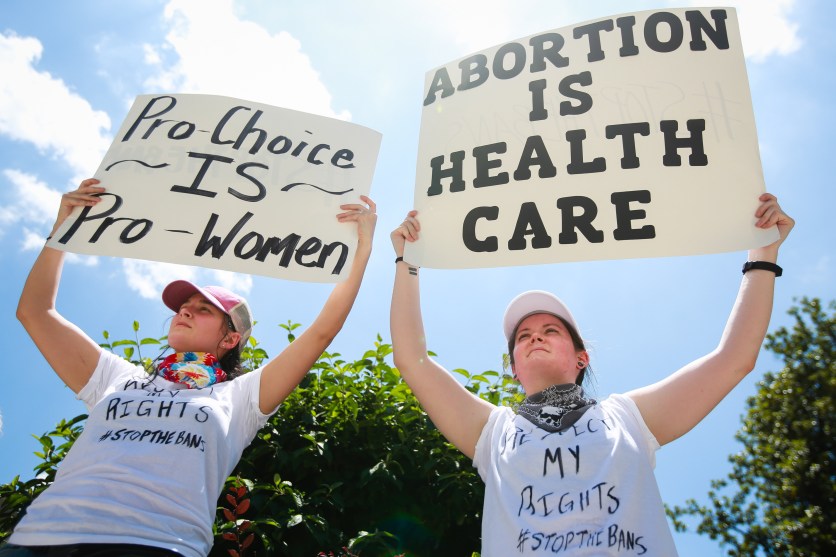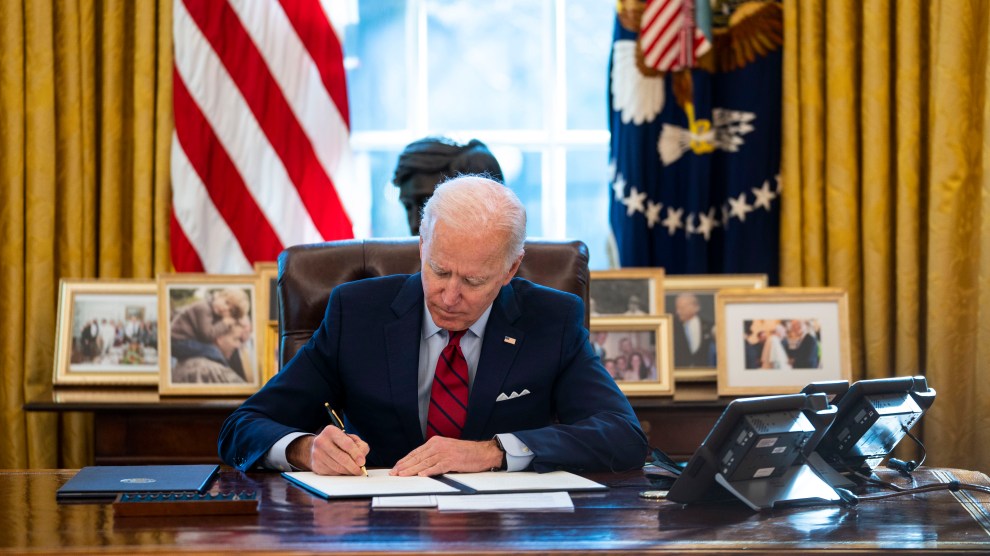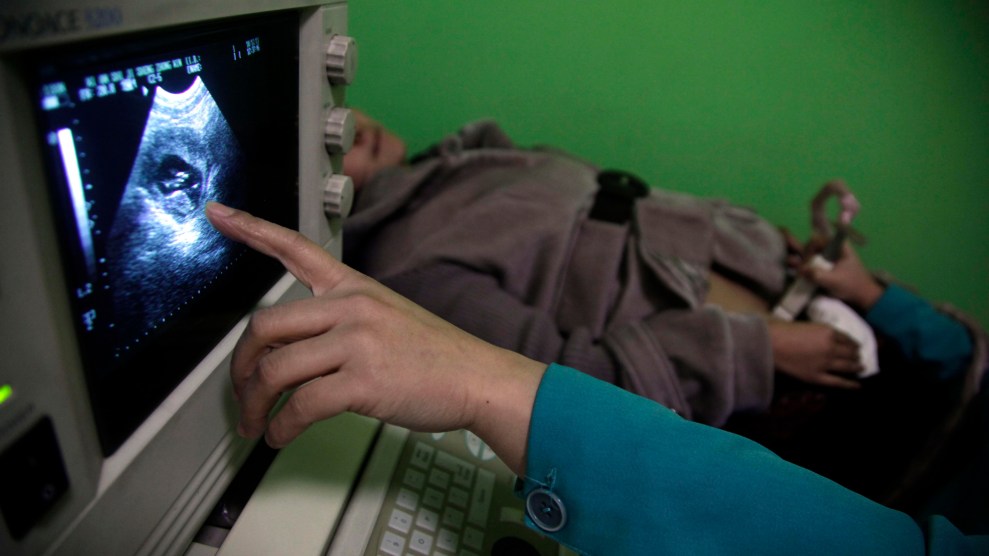
Elijah Nouvelage/Getty
Abortion advocates are finally on the offensive. Having barely made it through the last four years with Roe intact, the groups battling to protect the right to abortion can now, in theory, help set the agenda for their pro-choice president. And they are putting much of their energy into a single demand: End the ban on using federal funds for abortion care.
That ban, known as the Hyde Amendment, was passed by Congress in 1976 as an amendment to the federal budget. Thanks to Hyde, Medicaid health insurance can’t cover abortions—except in cases of rape, incest, or life endangerment—forcing low-income women to pay for abortions out of pocket. The amendment was the first major blow to abortion rights after Roe because it essentially cut off access to those who had always struggled to get care before the procedure was legalized.
“We know that, because of the Hyde Amendment, frankly, Roe hasn’t been a reality for many folks,” says Destiny Lopez, co-president of All* Above All, an abortion justice organization that has been among those leading the charge to end the ban. “We have to think about the repeal of the Hyde Amendment as being core to ensuring and restoring abortion access to all people in this country, not just those who can afford it.”
But is it enough to repeal Hyde, and can a president who supported the amendment for more than 40 years get onboard in the first place?
The significance of legalizing the use of state Medicaid funds for abortion care is not to be understated. In the years after Roe and before Hyde, Medicaid paid for some 300,000 abortions annually. Since then, a whole infrastructure and nonprofit industry—the abortion fund—has been created around pulling together funding for women who can’t afford their abortions.
Today, 2 in 10 women of reproductive age are covered by Medicaid, and as of 2018, more than 7 million of them live in states that strictly adhere to Hyde. Sixteen states get around Hyde by using their own funds to pay for abortions. But the majority of states—33, as well as the District of Columbia—follow the Hyde Amendment without any extra state funding. South Dakota has gone rogue and will only pay for abortions in cases of life endangerment. Women of color, who have higher rates of unintended pregnancy, are more likely than white women to rely on Medicaid for health insurance.
In a country where the bodies of Black, brown, and low-income women have been experimented on and disempowered of reproductive autonomy, excising the Hyde Amendment would have a massive effect. “Repealing the Hyde Amendment really is a necessary as part of the process of dismantling systemic racism and ensuring that our public policies support bodily autonomy and safe, healthy communities,” says Megan Donovan, a senior policy manager at the Guttmacher Institute, a think tank that researches reproductive health care.
But that’s easier said than done. Since its passage, getting rid of Hyde Amendment has been a nonstarter, even for Democrats. President Bill Clinton couldn’t do it. President Barack Obama even issued an executive order in 2010 upholding the amendment as part of a compromise in the battle over the Affordable Care Act. Every year the amendment must be approved as part of the budget, and every year the budget passes with Hyde unscathed. It’s been such a third-rail issue that repealing it was not even included in the Democratic platform until 2016.
But since then, ditching Hyde has slowly become more mainstream. Biden came out against the ban in June 2019 amid mounting pressure from advocates and progressive Democrats. He made the announcement at a Democratic fundraiser in Atlanta, saying, “If I believe health care is a right, as I do, I can no longer support an amendment that makes that right dependent on someone’s zip code.”
Advocates like All* Above All and others hope Hyde will be done away with via the EACH Woman Act, legislation originally introduced in the House in 2015 to expand abortion access by nixing Hyde and guaranteeing abortion coverage through Medicaid. It was reintroduced in 2019 in both the Senate and the House by a cohort of congresswomen, and though it has sat dormant ever since, the reproductive justice movement is lobbying the Biden administration and allies in Congress to reintroduce it once more and move it through the House and the Senate. Last week, a team of congresswomen introduced it once more—Barbara Lee, Jan Schakowsky, and Ayanna Pressley in the House, and Tammy Duckworth, Patty Murray, and Mazie Hirono will bring it before the Senate. The Biden administration has yet to comment specifically on the bill.
Not everyone is holding their breath that Biden will follow through. The president, after all, voted for the Hyde Amendment back in 1976, and he opposed exceptions for rape, incest, and life endangerment. As a senator in 1981, he voted for a constitutional amendment that would allow states to pass laws on whether abortion was legal within their borders. He cited his Catholic faith at the time, calling it “the single most difficult vote I’ve cast as a US senator.” It wasn’t a shock—the year after Roe was decided, he told an interviewer that the court had gone too far in its ruling, and a woman should not have “sole right to say what should happen to her body.”
And despite his comments last year suggesting he was ready to stand up for abortion rights, as president Biden has so far been demure on the subject. In her first press briefing as White House press secretary, Jen Psaki was asked about the Hyde Amendment and the Global Gag Rule, a policy barring the allocation of federal funds to organizations abroad that do so much as speak about abortion. Psaki responded by saying there would be more information about the gag rule in the coming days, and she ended on this note: “But I will just take the opportunity to remind all of you that he is a devout Catholic and somebody who attends church regularly…He started his day attending church with his family this morning.”
Advocates were outraged. “The fact that they get asked about it on day one, and not only do they not repeat or say the word abortion, but they perpetuate this false equivalency that the Catholic faith is somehow counter to abortion,” says Renee Bracey Sherman, founder and executive director of We Testify, an abortion storytelling nonprofit. “Biden goes to church—cool! So do the Catholics who have abortions.”
When Biden signed the executive orders that rolled back the gag rule the following week, he did not utter the word “abortion” in his remarks. According to Sherman, he hasn’t said the word once in his tenure as president, and it’s difficult to interpret that as anything other than a deliberate sidestep, at best.
Even if Biden does make good on his promise to get rid of Hyde, there’s another wrinkle that has nothing to do with the president: Medicaid reimbursement rates. When someone who relies on Medicaid for insurance coverage gets care, the provider files a claim with the state’s Medicaid and Medicare office, which reimburses the provider for the work. But over the past decade, reimbursement rates have fallen dramatically (thanks in part to political infighting over the Affordable Care Act), meaning providers often spend more than they make on Medicaid patients. That can put clinics, especially in rural areas where poverty rates are higher and a greater percentage of the population relies on Medicaid, in a tough spot. If Hyde were removed and clinics could bill for Medicaid, they would have to figure out how to deal with the financial loss. Instead of making even more cuts to fill in the financial gaps, some providers may choose not to accept Medicaid patients at all. In fact, a 2015–2016 study showed that even when a woman needed an abortion following the exceptions under Hyde, most providers would not accept Medicaid patients due to “spotty reimbursement and complicated billing.”
“Medicaid coverage is absolutely essential for all women,” says Jennifer Pepper, executive director at Choices in Memphis, which offers full-spectrum reproductive health care, including abortion care and labor and delivery. “But also, the Medicaid/Medicare payment structure is such that it makes it hard for medical providers to provide high-quality care.” Pepper says that when she became the executive director at Choices, she took a hard look at the clinic’s Medicaid reimbursements, a sizable portion of which were coming from its midwifery department: nine months of prenatal care, labor and delivery, and the minimum 56 hours of postpartum care the Choices midwives provide. “It’s a really time-intensive, high-quality amount of care,” she says. But that’s not reflected in what they get back from the Medicaid office. “It’s pennies on the dollar for the hours that they provide care. And so like, wow, they [state policymakers] don’t actually care about pregnant people, either.”
Independent abortion clinics, especially in states that are governed by conservative legislatures, have the added financial burden of keeping up with a steady onslaught of medically unnecessary regulations that drive up operating costs and make it difficult to stay afloat. Many also foot the bill for abortion doctors to travel to their clinics a few times a week—some physicians are afraid to live in areas where they and their families may face violent threats because of their profession. “Our clinic is certainly not trying to make a million dollars on health care,” Pepper says. “But we do want to do things like provide our staff a living wage and provide them benefits, and that is what helps us provide high-quality care to pregnant people—whether they want to end their pregnancy or give birth—because we’re able to take care of our staff, and we’re able to take care of our facilities and our equipment.”
Other independent clinics are concerned about a complacency that might follow a takedown of the Hyde Amendment that could affect follow-through on the crucial Medicaid reimbursement issue. “Activists will get their ‘victory’ and everyone will think things are better,” says Robin Marty, communications director at the West Alabama Women’s Center and author of The New Handbook for a Post-Roe America. “And the anger and the money and the resources will get directed to some other issue, and the South will get left behind again.”
Laurie Bertram Roberts, who serves as the executive director of two major abortion funds in the South, the Yellowhammer Fund and the Mississippi Reproductive Freedom Fund, wholeheartedly supports the repeal of the Hyde Amendment and agrees that the effort has to include health care reform. Without that, the campaign is meaningless. “How do you say you’re centering low-income women and women of color when one of the states that will be the least impacted by Hyde disappearing is Mississippi, which has the densest Black population in the country? And we will not benefit from Hyde disappearing, and neither will the South, which is where the majority of Black people in this country live,” she says. To be sure, it’s hard to imagine Mississippi’s already strapped health care providers being able to take on Medicaid patients, given the current health care infrastructure and economic challenges there. Plus, the state is down to one abortion clinic, which is only open three days a week, thanks to the steady flow of restrictions out of the state legislature.
To Roberts’ point, Mississippi has the highest poverty rate in the nation, and according to 2017 data from the Kaiser Family Foundation, more than 1 in 10 women in Mississippi receive health care coverage through Medicaid, meaning they likely can’t afford to pay for an abortion or nonemergency contraception on their own. In 2019, I went to Mississippi to follow a young woman who was trying to get abortion care with the help of Roberts’ reproductive freedom fund. The state’s health care infrastructure is inconsistent at best, and when it comes to reproductive health care, it is severely challenging for low-income people to have their needs met. As I wrote:
In 2016, the state health department closed nine [health] clinics; the following year, two-thirds of the department’s regional offices were shuttered due to a series of budget cuts. According to Roberts, some women she knows who rely on Medicaid have had to wait up to six months to get birth control. The state has a single Planned Parenthood, in Hattiesburg, that distributes birth control but does not provide abortion care—which, according to Barbara Ann Luttrell, director of communications for Planned Parenthood Southeast, “is because the state of Mississippi intentionally has made it next to impossible to be an abortion provider.” Planned Parenthood Southeast is also one of the most under-resourced affiliates in the country.
“I don’t think [outsiders] understand that the structural barriers are at every turn of care, that it starts before people even have sex,” Roberts says.
Advocates working on the Hyde campaign say throwing out the amendment and the limited abilities of independent clinics to make up the difference in meager reimbursement rates are not at odds. “Our health care system is not equitable—some of these providers have the same frustrations with private insurance,” says Ravina Daphtary, co-director of the All* Above All campaign. “They really come from the same place—a lack of care and compassion and desire to support those communities. What we want to see is a just health care system that gives people the care that they need and allows patients and providers to thrive and provide this care sustainably.”
National advocates are keeping the pressure on the Biden administration. “We want to see the administration submit a clean budget—a budget without the Hyde Amendment,” Daphtary says firmly.
Biden’s hesitation to wholeheartedly show support for abortion rights is particularly worrisome given the fight that is sure to break out if the Hyde Amendment were struck down. Allowing Medicaid and other federal insurance programs to cover abortion care would face resistance from states that are hostile to abortion rights. In a scenario in which Hyde is stricken from the budget, Elizabeth Nash, interim associate director of state issues at Guttmacher, says lawmakers in states hostile to abortion would challenge the change in court. Even now, 9 of the 16 states that use their own funds to cover abortions only due so because the courts forced them to.
And if abortion stigma continues to trickle out of the White House, Democratic president or not, the consequences of Biden’s nervous dance around the word “abortion” will only continue to embolden opponents and hamper progress.
“Biden is like, ‘Build back better’ for everybody else, but for abortion, it’s ‘Build back the bare minimum,’” Bracey Sherman says. “I’m very, very frustrated with this lip service of, ‘Black women are the backbone of this country, Black women are saving our democracy,’ and when Black women have very specific asks—like repealing the Hyde Amendment, making sure that we have access to maternal health care, and making sure that we have access to abortion, making sure that abortion is not criminalized—this nation once again turns their back.”
This article has been updated.
















